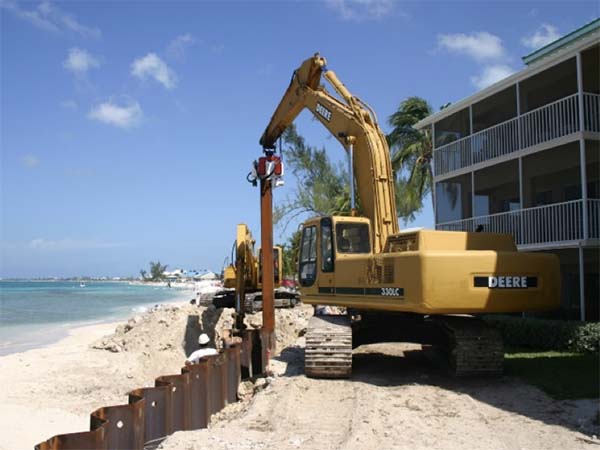Steel sheet piles, as an efficient, economical and highly adaptable foundation pit support and retaining structure, their construction quality directly affects the safety and stability of the project. In actual construction, depending on the geological conditions, the length of the pile wall, the precision requirements and the construction environment, the appropriate driving method should be flexibly selected. Common construction techniques include individual driving method, screen-type driving method, jumping driving method and combined pile wall construction method, etc. Each method has its own characteristics. Below, I will provide a detailed analysis of these methods to help everyone grasp the key points.

1. One-pile driving method (single-pile driving method)
Starting from one side of the pile wall, drive each pile into the soil one by one. During construction, no auxiliary supports are needed; a pile driver can be used for continuous operation directly. This method is the simplest way to drive piles, but during the process, the sheet piles may tilt. It is suitable for projects where the soil is relatively soft, the length of the sheet piles is small and the precision requirements are not high.
2. Screen-type entry method
By inserting 10 to 20 sheet piles in rows into the guide frame to form a screen-like structure, the piles are driven in batches. Generally, the positioning piles at both ends are first driven to the designed depth, and then the middle piles are driven in a stepped manner. As the entire row of piles is positioned simultaneously, it can effectively reduce the accumulation of inclination errors, and is easy to close and close, resulting in high construction quality. If obstacles are encountered during the pile driving process, individual piles can be left behind without affecting the overall efficiency. The disadvantages are that guide frames need to be set up, the construction speed is relatively slow, and the height requirements for the pile frame are relatively high.
3. Jump hitting method
This method involves driving in at intervals, such as driving odd-numbered stakes (No. 1, 3, 5) first and then even-numbered stakes (No. 2, 4), to form a "large interval jump drive" or a "small interval jump drive" (such as 1-3-2-5-4). Under harsh geological conditions, it is recommended to combine the screen-type driving method and the jumping driving method, and install the corresponding sheet piles between the guide frames. If the soil is very dense sandy soil or rock, the tips of piles No. 1, No. 3 and No. 5 can be reinforced. In this case, the piles reinforced with these tips should always be driven first, followed by the other piles No. 2 and No. 4. This method can prevent unilateral soil compression and reduce the risk of tilting. It is suitable for hard soil layers or harsh areas. However, its drawback is that the sequence of pile driving needs to be precisely controlled, resulting in relatively low construction efficiency.
4. Combined pile wall driving method
A composite wall is a pile wall composed of main piles and steel sheet piles in the middle. The main forms of main piles mainly include pipe piles, box piles, load-bearing piles and other forms of fabricated piles.
The composite pile must provide a stable, heavy-duty and sufficiently rigid guide frame suitable for the pile length and weight.
The main pile is positioned on the guide frame by welding the guide plate support, which takes into account the width deviation.
When driving in the main piles, it is necessary to be extremely careful. It is essential to ensure that the main piles are driven straight and verticality, or maintain the specified slope to ensure they are parallel to other piles and keep the specified gap.
The driving sequence of the main piles must ensure that the entire tip of the pile is evenly in contact with the compacted soil around it, and must not be on one side. Therefore, the following sequence must be followed for pile driving: 1-5-3-6-4-7-2 (large interval jump driving), or at least the following sequence: 1-3-2-5-4-7-6 (small interval jump driving).
This method provides stability for the main piles and fills the gaps with auxiliary piles. It is suitable for complex strata or high-load projects, but the construction is relatively complex and requires coordination of the verticality and closure accuracy of the auxiliary piles.
